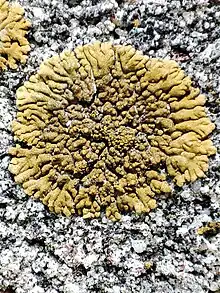| Calogaya decipiens | |
|---|---|
 | |
| Scientific classification | |
| Domain: | Eukaryota |
| Kingdom: | Fungi |
| Division: | Ascomycota |
| Class: | Lecanoromycetes |
| Order: | Teloschistales |
| Family: | Teloschistaceae |
| Genus: | Calogaya |
| Species: | C. decipiens |
| Binomial name | |
| Calogaya decipiens (Arnold) Arup, Frödén & Søchting (2013) | |
| Synonyms[1] | |
|
List
| |
Calogaya decipiens is a species of saxicolous (rock-dwelling), crustose lichen in the family Teloschistaceae.[2] It was first scientifically described in 1867 by German lichenologist Ferdinand Christian Gustav Arnold, as a member of the genus Physcia.[3] Ulf Arup and colleagues transferred the taxon to the genus Flavoplaca in 2013, following a molecular phylogenetics-based restructuring of the family Teloschistaceae.[4]
References
- ↑ "Synonymy. Current Name: Calogaya decipiens (Arnold) Arup, Frödén & Søchting, Nordic Jl Bot. 31(1): 38 (2013)". Species Fungorum. Retrieved 1 November 2023.
- ↑ "Calogaya decipiens (Arnold) Arup, Frödén & Søchting". Catalogue of Life. Species 2000: Leiden, the Netherlands. Retrieved 1 November 2023.
- ↑ Arnold, F. (1867). "Die Lichenen des fränkischen Jura". Flora (Regensburg). 50: 562.
- ↑ Arup, Ulf; Søchting, Ulrik; Frödén, Patrik (2013). "A new taxonomy of the family Teloschistaceae". Nordic Journal of Botany. 31 (1): 16–83. doi:10.1111/j.1756-1051.2013.00062.x.
This article is issued from Wikipedia. The text is licensed under Creative Commons - Attribution - Sharealike. Additional terms may apply for the media files.